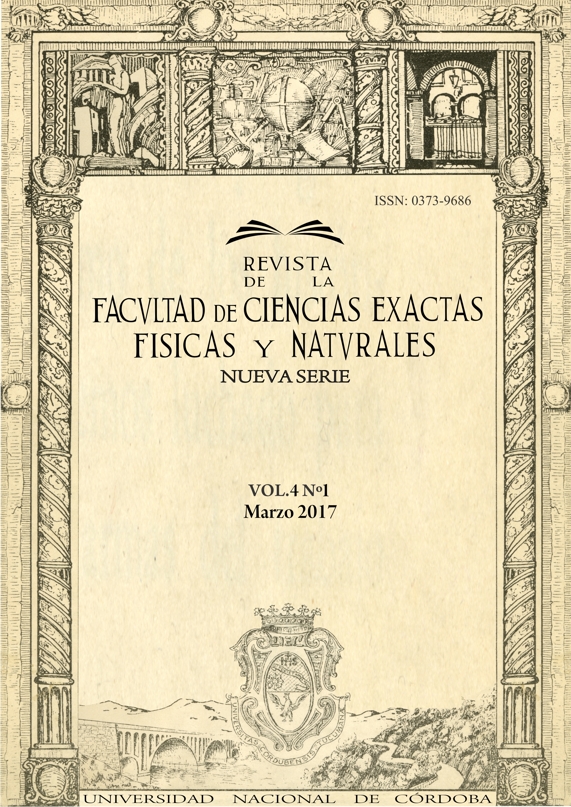Biotecnología, un pantallazo
Palavras-chave:
Biotecnología-Productos Biotecnológicos-Servicios BiotecnológicosResumo
La biotecnología es una disciplina científica que desarrolla productos y servicios dirigidos a la agricultura, la industria alimentaria/farmacéutica/textil/ del papel/del biocombustible, etc. Entre los servicios están todos aquellos referidos a la bio-remediación de suelos, agua y aire contaminados, la reproducción asistida, la medicina personalizada, el diagnóstico médico. Esta disciplina surge fundamentalmente del aprendizaje del manejo del ADN y del conocimiento de la información del propio ADN. Entre las técnicas del manejo del ADN están las de transferencia de genes de una especie a otra no emparentada, y las modificaciones en el propio genoma de los individuos. Existen tantas ideas para llevar a cabo que se produce una situación curiosa. Muchos países desarrollados asiáticos no cuentan con suficiente cantidad de científicos para llevarlas a cabo y ofrecen facilidades a extranjeros para instalar sus laboratorios allí.
Downloads
Referências
[1] Ledford H. (2013). “Transgenic salmon nears approval”. Nature 497: 17-18.
[2] Sun M. (1984). “Cohen-Boyer patent to be issued soon”. Science 224(4646): 264.
[3] Dalrymple MA y Garnes I. (1998). Genetically modified livestock for the production of human proteins in milk. Biotechnol Genet Eng Rev 15: 33-49.
[4]Programa educativo de ArgenBio: ¿Por qué biotecnología? (disponible en http://www.porquebiotecnologia.com.ar/).
[5] Sanchis V., Agaisse H., Chaufaux J. y Leredus D. (1996). “Construction of a new insecticidal Bacillus thuringiensis recombinant strains by using the sporulation non-dependent expression system of cryIIIA and site specif recombinant vector”. J Biotechnol 48 (1-2): 81-96.
[6] Stokstad E. (2016). “European Commission gives controversial weed killer a last-minute reprieve”. Science DOI: 10.1126/science.aag0630.
[7] “Soja resistente a sequía, HAHB-4” (disponible en www.bioceres.com.ar).
[8] “Papa resistente RPY” (disponible en http://sidus.com.ar/).
[9] “Papa que produce solo amilopectina” (disponible en www.basf.com/ar/).
[10] “Papa portadora de gen de arroz resistente a hongos” (disponible en www.basf.com/ar/)
[11] Murata M.,Nishimura M.,Murai N.,Haruta M.,Homma S. y Itoh Y (2001).” A transgenic apple callus showing reduced polyphenol oxidase activity and lower browning potential”. .Biosci Biotechnol Biochem.65(2):383-8.
[12] Shen B., Sun X., Zuo X, Shilling T., Apgar J., Ross M., Bougri O., Samoylov V., Parker M., Hancock E., Lucero H., Gray B., Ekborg N.A., Zhang D., Johnson J.C.S., Lazar G.y Raab R.M. (2012). “Engineering a thermoregulated intein-modified xylanase into maize for consolidated lignocellulosic biomass processing.”.Nature Biotechnology 30: 1131–1136
[13] Harfouche A., Meilan R., Kirst M., Morgante M., Boerjan W., Sabatti M. y Scarascia Mugnozza G. (2012). “Accelerating the domestication of forest trees in a changing world”. Trends Plant Sci 17:64-72.
[14] Ye X., Al-Babili S., Klöti A.,Zhang J.,Lucca P.,Beyer P. y Potrykus I. (2000). “Engineering the provitamin A (beta-carotene) biosynthetic pathway into (carotenoid-free) rice endosperm”. Science 287 (5451): 303-305.
[15] Stoger E., Fischer R., Moloney M. y Ma J. K..C.. (2014). “Plant molecular pharming for the treatment of chronic and infectious diseases,annual”. Review of Plant Biology 65: 743-768.
[16] Leche maternizada (disponible en inta.gob.ar/noticias/rosita-isa-produce-201cleche-maternizada201d)
[17] “PAMPA MANSA “(disponible en www.relacionespublicas.com/.../Bio%20Sidus%20-%20Tambo%20Farm...)
[18] Jaunmuktane Z., Mead S., Ellis M., Wadsworth J.D.F., Nicoll A.J., Kenny J., Launchbury F., Linehan J., Richard-Loendt A., Walker A.S., Rudge P., Collinge J. y Bradner S. (2015) “Evidence of amyloid-ß pathology and cerebral amyloid angiopathy”. Nature 525: 247-250.
[19] “Dolly” (disponible en www.roslin.ed.ac.uk/.../dolly-the-sheep/a-life-of-doll..).
[20]”SAMBA” (disponible en www.clarin.com/.../clonacion-animales-muertos-realidad-avanzando_0_.).
[21] Cyranoski D. (2015).” Gene-edited “micropigs” to be sold as pets at Chinese institute”. Nature 526: 18.
[22] Devitt E. (2016). “As lab-grown meat and milk inch closer to U.S. market, industry wonder who will regulates? (disponible en http://www.sciencemag.org/news/2016/08/lab-grown-meat-inches-closer-us-market-industry-wonders-who-will-regulate).
[23] Amiram M., Haimovich A.D., Fan C., Wang Y.S., Aerni H.R., Ntai I., Moonan D.W., Ma N.J., Rovner A.J., Hong S.H., Kelleher N.L., Goodman A.L., Jewett M.C., Söll D., Jesse Rinehart J.y Isaacs F.J.(2015). “Evolution of translation machinery in recoded bacteria enables multi-site incorporation of nonstandard amino acids”. Nature Biotechnol. 33: 1272–1279.
[24]Bohannon J. (2016). “Mission possible: Rewriting the genetic code”. Science 353(6301): 739.
[25] Thodey K., Galanie S. y Smolke C.D.(2014). “A microbial biomanufacturing platform for natural and semisynthetic opioids”. Nature Chemical Biology 10: 837-844.
[26] Macintyre G., Ylstra B. yBrenton J.D. (2014).“Sequencing Structural Variants in Cancer for Precision Therapeutics”. Trends in Genetics 32 (9): 513-542
Downloads
Publicado
Edição
Seção
Licença
Los autores que publican en esta revista están de acuerdo con los siguientes términos:
Los autores conservan los derechos de autor y conceden a la revista el derecho de la primera publicación.
Los autores pueden establecer por separado acuerdos adicionales para la distribución no exclusiva de la versión de la obra publicada en la revista (por ejemplo, situarlo en un repositorio institucional o publicarlo en un libro), con un reconocimiento de su publicación inicial en esta revista.
Se permite y se anima a los autores a difundir sus trabajos electrónicamente (por ejemplo, en repositorios institucionales o en su propio sitio web) antes y durante el proceso de envío, ya que puede dar lugar a intercambios productivos, así como a una citación más temprana y mayor de los trabajos publicados (Véase The Effect of Open Access) (en inglés).



